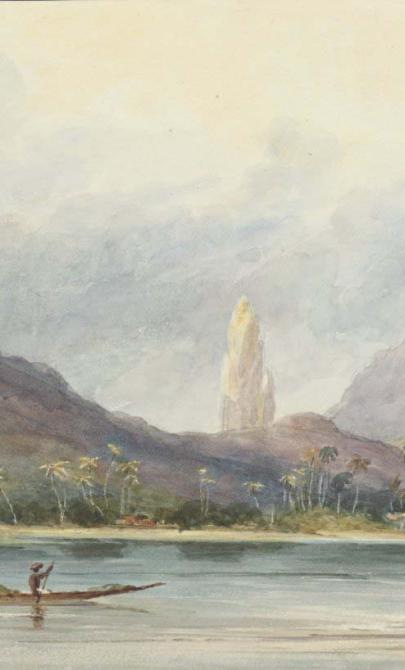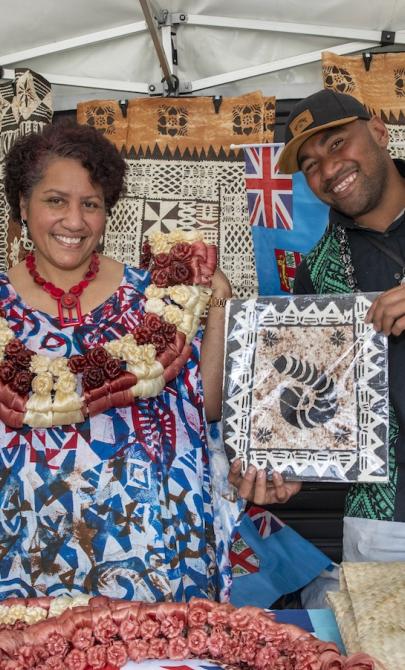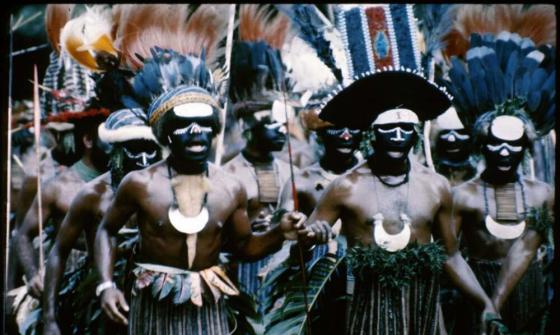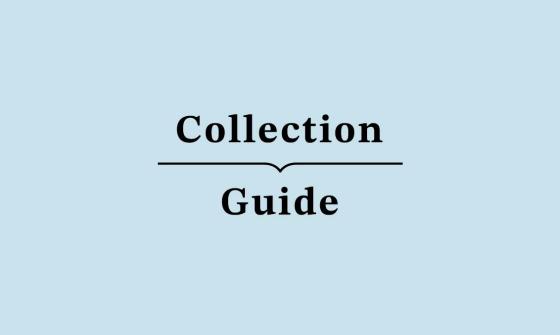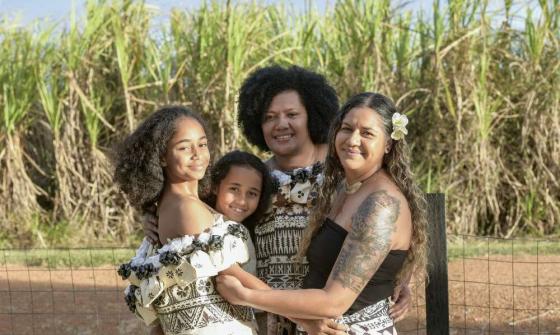Pacific research guide
About the collection
The Library holds a rich and diverse range of documentary materials relating to the Pacific region, including Melanesia, Micronesia, Polynesia and New Zealand.
Our Pacific collection features excellent holdings of books, journals, newspapers, manuscripts, maps and pictures, as well as ephemera and selected websites, from the earliest accounts of European exploration of the region to contemporary publications. See Pacific collections for a general description of the Pacific-related material held in our collections and highlights some of our treasures in this area.
This guide aims to assist researchers in identifying and using the Library’s collection and provide pathways to a variety of other resources beyond the Library’s collections.
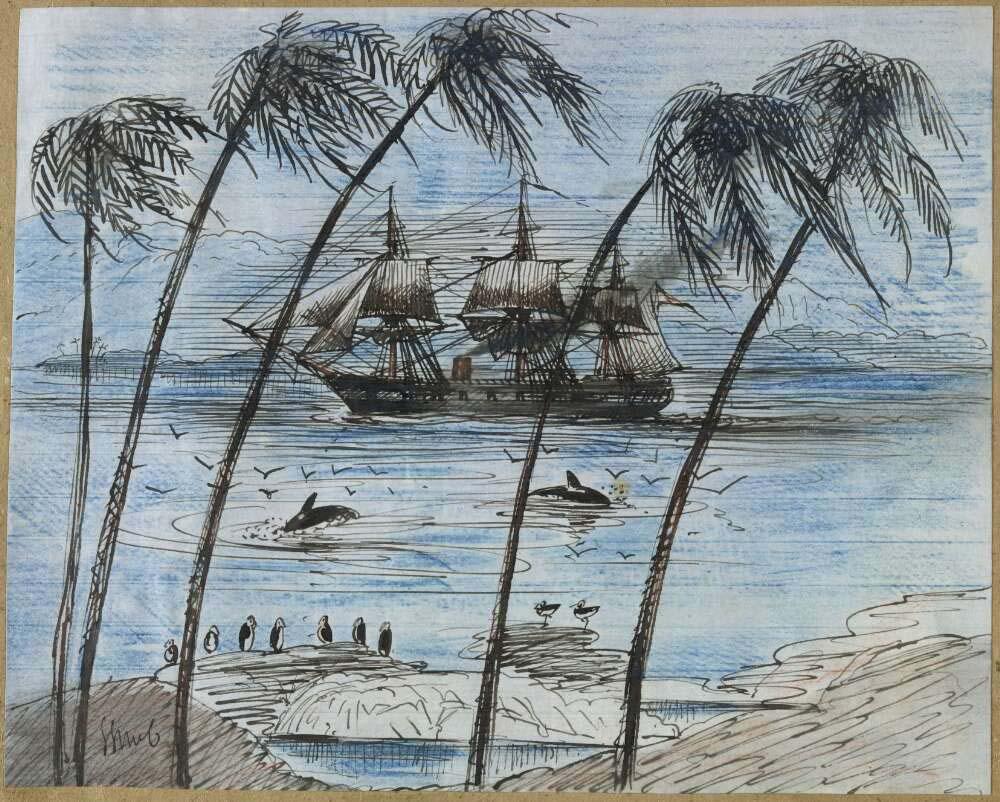
George Gordon McCrae, [Sailing ship near Pacific island], nla.gov.au/nla.obj-139352101
George Gordon McCrae, [Sailing ship near Pacific island], nla.gov.au/nla.obj-139352101
Searching the Library's collection
The best way to explore the Library's collection is to use our online catalogue.
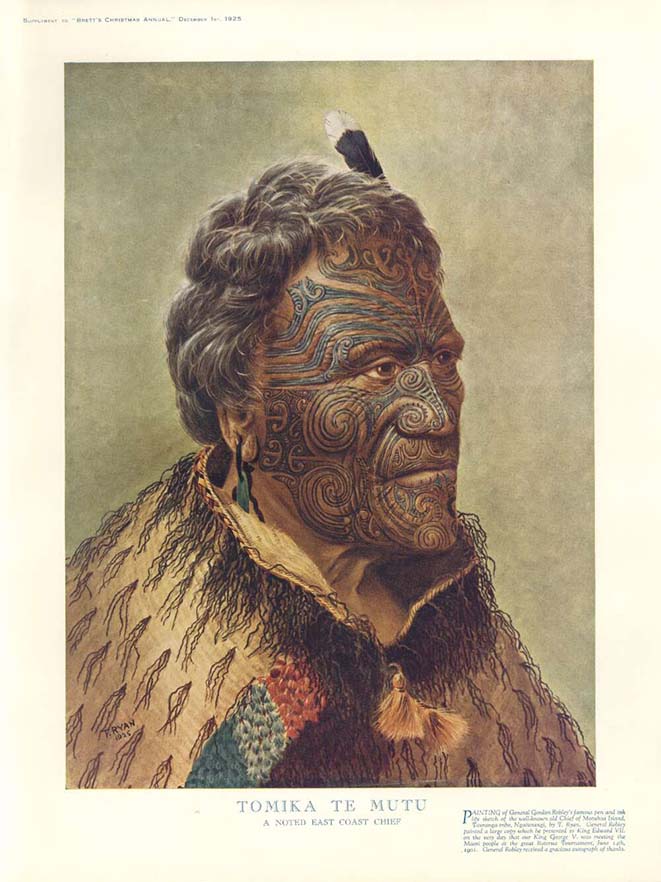
T Ryan & Horatio Gordon Robley & Brett's Christmas Annual, (1905), Tomika te mutu, a noted east coast chief, nla.gov.au/nla.obj-140438726
A simple search of the catalogue using terms such as 'Pacific', 'Pacific Islands' or the names of specific islands, regions or countries, such as 'Fiji' or 'Melanesia' or words in the title, author's name and subject terms will locate relevant collection items the Library holds.
It works better to start with a broader term then use the options at the right of the page under 'Narrow search' to sort search results. The options to help refine search results list include format, such as book, map, microform, manuscript, journal, picture, and date, subject and language. You can also limit the results to include online or digital materials only.
The catalogue also allows you to browse the collections by title, author, and series..
With a Library login, you can request items to use in the reading rooms. If you are unable to visit the Library, you can use our Copies Direct service to order a copy of an item, subject to copyright provisions, and have it sent to you via email.
For more information on catalogue search and our collection delivery service, see: Start researching.
Suggested resources
Microfilm of 78 manuscripts copied by the Commission, written by missionaries, anthropologists, and linguists between 1900 and 1956 and publications produced by the Commission.
German colonies in the Pacific
Papers and microfilm of original records relating to the German colonies in the Pacific from 1884-1914.
Researching the Pacific
Researching the Pacific
Alex Cameron: Hello and welcome to the Researching the Pacific Learning Webinar. My name is Alex.
Jame Cruz: And I'm James.
Alex Cameron: We're reference librarians here at the National Library.
James Cruz: Before we start, we would like to acknowledge Australia's First Nations peoples - The First Australians - as the traditional owners and custodians of this land, and give our respects to their elders, past and present and through them to all Australian, Aboriginal and Torres Strait Islander people.
Alex Cameron: Additionally, the resources that we present in today's webinar may contain images or voices of deceased persons and may also reflect the bias, norms and perspectives of the period of time in which they were created. We accept that these may not be appropriate today.
James Cruz: Today, we'd like to guide you through the collections the National Library holds that will help you research the Pacific region, including resources on Fiji, Papua New Guinea, Tonga and more.
We'll show you the range of materials available from the National Library, including historical maps and photographs, newspapers in language magazines and oral histories.
Many of the items we'll show have also been digitized and are freely available to look at online through the National Library.
While it's not possible to talk about all of our Pacific holdings and resources today, we aim to show you some of the highlights from our collection.
Alex Cameron: We'll also talk about the Pacific Manuscripts Bureau, known as PMB or PAMBU, which is based at the Australian National University. And hear from Kari James, PAMBU's executive officer.
James Cruz: The National Library has a number of large format collections, some of which contain lots of useful records about life in the Pacific.
One of the Library's most significant Pacific collections is the Rex Nan Kivell collection, which was acquired by the National Library in 1962.
The collection comprises of approximately 5000 books, pamphlets and journals, as well as over 800 maps, 300 plus manuscript items, and a large collection of photographs and paintings which are largely related to the lands in the Pacific from 1751 to 1900.
The collection contains a wealth of material about maritime exploration of the Pacific, such as letters from prominent figures like James Cook and Joseph Banks, journals from the 1700s detailing voyages, as well as maps and nautical charts detailing lands through the Pacific region.
There's also missionary records such as correspondence from missionaries belonging to the London Missionary Society and records belonging to reverends Posted in New Zealand and Tonga.
Alex Cameron: Arguably, one of the most exciting parts of the collection is the collection of prints, paintings and photographs. The collection is huge with over 3000 paintings and over 8000 prints.
While much of the collection depicts Australian scenes, there are many beautiful works showcasing scenery and day to day life within the Pacific region, with depictions of Tahiti by Sydney Parkinson, Tonga by John Weber, Hawaii by Jaques Arago and the Mariana Islands by Louis Choris.
James Cruz: Another formed collection of interest for Pacific Research is the Chinnery Collection, which contains manuscript papers, maps and photographs related to Papua New Guinea in the early 1900s.
There is a wide variety of cartographic material in the collection with patrol maps of Papua New Guinea, native crop distribution maps, geological maps and maps depicting language barriers in the region.
The photographic collection is also quite extensive, covering Ernest Chinnery’s work as a patrol officer with photographs of his patrols in Kumasi, Mumbare and Delta divisions in Papua. His Mount Yule expedition in 1917, visits to the Sepik district and more. Chinnery’s wife, Sarah, was also a photographer who captured scenes of villages and homes in Papua.
Alex Cameron: The Spencer Collection, another of our formed collections, contains a wealth of photographs of Papua New Guinea. Dr Margaret Spencer, an entomologist, and Dr Terence Spencer, a malariologist, worked in epidemiological studies in Papua New Guinea from the 1950s to the 1970s. The collection includes photographs of Port Moresby, the Wahgi Valley in the Western Highlands, the D’Entrecasteaux Islands of Papua, New Guinea islands, including the Tasmans and Mortlocks, and Bougainville Island. The photographs mostly capture landscapes, village life ceremonies and patrol work over those years.
If you would like to know more about these collections, comprehensive overviews of the Nan Kivell and Chinnery collections are available online. Simply visit our website and navigate to the Guide to Selected Collections page.
James Cruz: The Nan Kivell, Chinnery and Spencer collections can be accessed via our National Library catalogue.
To find this material in the catalogue simply type in the name of the collection in the text box, then select the material format from the Add Limits” dropdown menu.
For example, you can type generate and select picture from the dropdown menu, and this will show you photographs from the Chinnery Collection.
If you're interested in digitised content that you can access from wherever you are, use the National Library's digital material filter on the right hand side to limit your results. For example, this beautiful engraving of a New Zealand chief, part of the Nan Kivell collection, is available to view online.
If you would like to access the original physical material, you can request items in the catalogue using your National Library card, and they will be delivered to one of our reading rooms in Canberra.
If you're interested in looking at other maps and photos that aren't part of these formed collections, the catalogue makes it quite easy to do. By limiting your search to maps or picture under the Add Limits” field, you find plenty more maps and images relating to the Pacific region. There will be a number of those already digitised and freely available on Trove, while others will need to be called up to a reading room to be looked at more closely.
Alex Cameron: Moving on from our formed collections, newspapers and magazines are another excellent source of information for researching the history of the Pacific.
As these give you insights into what was happening in specific communities at a given point in time. The National Library has a very large collection of current and historic newspapers from places such as Fiji, Tonga, New Zealand and the Marshall Islands, which can be searched using our online catalogue to search for newspapers.
Put the place name into the search box. Select newspaper from the “Add Limits” dropdown menu and click find.
Some of our newspapers are digitised and are available to read online. These will have a direct link to the newspaper in the catalogue record.
Others are available as microfilm and paper copies, which can be requested with your National Library card to use in our reading rooms.
James Cruz: You can also use Trove to find historical newspaper articles and magazines about Pacific Nations.
A great Pacific resource that is available through Trove is the Pacific Islands Monthly magazine. The magazine ran for 70 years from 1930 to 2000 and covers news items from Pacific countries. Although originally published in Australia, it does document current events and topics in Pacific countries. Every issue of the magazine has been digitised and is freely available on Trove.
Alex Cameron: If you are looking for current articles rather than historical ones, you can do so using the databases Press Reader and NewsBank Access Global. These databases contain online, newspaper and magazine articles from a wide range of countries, including many from the Pacific region.
To access these databases, visit the National Library website and click the button for the eresource portal. From there sign in using your National Library card. Click the Browse a resources tab and search for the name of the database such as Press Reader. To find Pacific content in Press Reader click the “All Countries” dropdown menu and select the countries you are interested in. For example, if we select Fiji and click done, we can see the full range of Fiji and content in both English and in local languages. In NewsBank, click the items add source list at the top of the page and type the place name into the search box.
James Cruz: Another valuable source of information for researching the Pacific, in particular Fiji, are Indian emigration passes to Fiji. While the National Archives of Fiji are the custodians of the original material the National Library of Australia has digitised the passes to make them more widely accessible. The records in this collection comprise approximately 60,000 passes issued to Indians who came to Fiji as indentured labourers
To find out more about Indian emigration passes and how to access them, our colleagues, Judith and Jack, presented a webinar on this topic. The recording of which is available to watch via the Library's YouTube channel.
Alex Cameron: Oral history recordings are an amazing resource for researchers as they allow you to hear people's experiences in their own words and voices.
The National Library has been actively trying to preserve these stories with our most recent project to collect Fiji and Australian oral histories. Australia is home to more expatriate Fijians than any other country, and migrants from Fiji have made a considerable contribution to Australian society in music, academia, sports and many other areas. Recording these stories for future generations captures the unique experience and perspective that Fijian Australians have on events that shaped their community and Australia as a whole. Collecting and preserving Fijian, Australian experiences and materials is an ongoing priority for the National Library. More information about this can be found on the National Library website under the Collecting Priorities page.
James Cruz: To find oral histories in our catalogue, enter a person's name or a place name into the search bar and select audio from the “Add Limits” dropdown menu.
Some of the recordings can be listened to online. For example, here's a clip of Sevuloni Waqatairewa interviewed by Thelma Thomas for the Fijian-Australian Oral History Project,talking about his childhood memories.
Thelma Thomas: So what was it like going to school in Nausori?
Sevuloni Waqatairewa: I was there for a very short time, so the memories I could remember were was the lining up for the classroom. I remember my teacher. I remember trying to adjust and trying to understand the relationship now at school, which is different from my relationship with friends and cousins and relatives in the village. So it was interesting.
Alex Cameron: It is important to note that there are many organisations outside of the National Librarywho hold valuable resources and information for researching the Pacific region.
These organisations include Digital Pasifik, a collaboration between the National Libraries of New Zealand and Australia, as well as the Department of Foreign Affairs, that aims to empower the people in and of the Pacific Islands, enabling them to see, discover and explore items of digitised cultural heritage that are held in collections around the world.
Another is the Pacific Manuscripts Bureau, or PAMBU which leads us to a special guest, Kari James, the Executive Director of PAMBU.
Kari, thank you for joining us today and telling us about the work the PAMBU does.
Kari James: Hi. Thanks for having me here today.
James Cruz: So how about we start off with could you tell us about the Pacific Manuscripts Bureau and how it came to be?
Kari James: The Pacific Manuscripts Bureau or PAMBU, as it's more commonly known, was established at the Australian National University here in Canberra, back in 1968. ANU Pacific scholar, Harry Maude, was finding it difficult to access the primary documentation that he wanted for his research because documents were often in remote parts of the Pacific, which were difficult to access. Or they'd been taken out of the Pacific and were sitting in the archives of colonial powers or church headquarters, or in private hands when business people and others had left the islands.
Maude used to talk to librarians at the Mitchell Library in Sydney and the University University of Hawaii about this problem. And the idea was formed to combine the resources and send someone into the Pacific with a portable microfilm camera to make copies of archival materials and to share the copies with those libraries who had contributed funds to enable these field trips.
Then the National Libraries of Australia and New Zealand also came on board, and so it started out as this consortium of these five institutions.
The initial idea was just to create a catalogue of Pacific Archives, but it was the Mitchell Librarian, Gordon Richardson, who first voiced concern about the damage the tropical climate can do to paper and advocated for making preservation copies of the archival materials themselves.
More than 50 years later, we still operate in much the same way, except that we now use a digital camera rather than a microfilm camera. And there are now 14 sponsoring libraries in the consortium, which has grown from the original five.
Alex Cameron: Okay, so how does PAMBU actually acquire your collection material, particularly from places that are quite remote?
Kari James: So PAMBU doesn't acquire collection material in the way that most libraries would use the term acquire. We don't acquire a physical collection. Instead, we're reformatting or copying archive. Our collection only consists of rolls of microfilm and digital files, and pambo itself doesn't hold the microfilm collection at all. These have all been distributed to the member libraries, including the National Library of Australia. And these libraries then facilitate access for researchers.
The executive officer, who is often the only full time member of PAMBU staff, will travel to an organisation in the region that is interested in having their collection copied and shared. We then work at their premises so those collections don't ever have to be removed from their custodians.
We do also invite the collection custodians to access restrictions for any materials that might be culturally or politically sensitive. And we also supply the custodian or local library of the choice with a copy of the microfilm or digital. copy as well.
If needed we also assist with arranging, listing and rehousing collections as part of this reformatting process, and we try to make about three or four of these trips each year.
I haven't made any trips to anywhere too remote, and the pandemic has obviously made travel impossible for the last few years. Most of my fieldwork has been in and around Suva, in Fiji, but I'm working towards a more remote trip next year.
My predecessors have certainly done some more remote work. I always think fondly about Ewan Maidment's beautiful description about visiting the Russell Islands chain in the Solomon Islands to copy records on a plantation. And he writes about traveling by boat and watching with great admiration at the drivers ability to navigate using the stars.
I've also read stories in past issues of our newsletter about flying in small planes and torrential rain and other sort of challenging travel situations.
We also work with collections that are held in private hands. There are a lot of people who have lived and worked in the Pacific as colonial administrators, academics, missionaries, volunteers or business people. And during that time they might have collected community newsletters or kept a journal or taken photographs. And those materials are often just sitting in people's homes and garages when they may actually be useful to researchers.
On a recent visit to a private collection, a Papua New Guinean colleague of mine found photos of his own family and village in this person's photo album, which was really wonderful to witness him seeing these photos of his own family for the first time.
James Cruz: Wow, that's incredible. What kind of materials are collected by PAMBU? What would you most be commonly collecting?
Kari James: Our collecting policy is very broad. We collect from anywhere in the Pacificon really any subject. We prioritise materials that may be at risk of loss or destruction due to the humid climate or extreme weather events or collections that might just be really difficult to access or even be highly sought after.
The materials should also have some research value as well, whether that is personal research for things like family or local history, or whether that scholarly research.
Most of our member libraries are university libraries,so the sorts of materials we copy are usually of interest to academic researchers across a whole range of disciplines.
But we have photos and newspapers and diaries and vernacular publications, things that will be of interest to all sorts of people with a range of interests, with materials on health, politics,economics, linguistics, agriculture, government records. So all sorts of subjects in, in a variety of record formats.
The two most common subjects in the collection are whaling and religious missions.
The religious mission materialsare very useful to all kinds of scholars because they are some of the earliest written documents about the Pacific. We have a lot of records made by the churches themselves, but also a lot of letters and diaries of missionaries which record their experiences and observations. The papers of churches and missionaries are useful for all sorts of research, for contextualising archeological research, giving eyewitness accounts of conflicts like World War One or Black Birding raids. They often document languages and cultural practices, some of which are now endangered. They document historic events, land transactions, whether observations and events which are now being used by climate researchers. And of course, they tell the storyof the spread of Christianity in the region, which is a huge area of scholarly and personal research.
Our current collecting priorities are gathering voices we don't always hear from in early written documents such as Pacific Islanders themselves, women and minority ethnicities. There's also growing interest in Pacific Archives from the environmental history community.
We've not worked in the Northern Pacific as much as we have in the South Pacific, and we'd certainly welcome any opportunities to work with organisations in that part of the region.
Alex Cameron: Would you be able to share some of the history of how items and materials were able to be preserved by PAMBU? It sounds like the precarity of some of these records and for a variety of reasons, that's why PAMBU's working so essential.
Kari James: Most of the projects we take on a fairly straightforward, mostly organisations or individuals will approach us, or we may approach them or offer an introduction that might be made by an ANU researcher who finds collections in the process of their research.
Sometimes, though, there are more urgent circumstances. For example, in 2004, after Cyclone Heta hit Niue and destroyed a lot of government records, PAMBU was invited by the government of Niue to go over and to make microfilm copies of important records that had survived the cyclone.
The Executive Officer at the time, Ewan Maidment, talks about setting up his microfilm camera in a in a shipping container where a lot of the wet records were drying. And he describes having to having black cloth over the entrance to the shipping container to keep out the light for his microfilming but needing to leave the door open because the smell of damp was just so overpowering.
I think that the change in climate means that there is much, if not more risk to archival collections in the Pacific than before. And thankfully there is much greater awareness of this now than when PAMBU started out in the 1960s, but there's still a lot of work to do.
We've also copied some collections where there was perceived or very real risk from civil conflict. In the 1990s, PAMBU copied records in Fiji that had survived an attack during one of the coups. We have also microfilm archives in Solomon Islands that reportedly have since been destroyed by fire during a period of civil unrest.
And this year I've been working with the PNG National Fisheries College to supply copies of research papers that we microfilmed in their library years ago and library has since burnt down, so it's been great to be able to supply them with copies of some of the materials that they lost in this in this fire.
Now, these circumstance are not in our everyday business for PAMBU, but they do happen and they highlight just how easily documentary heritage can be lost.
James Cruz: That’s just incredible Kari. It's so exciting to hear the lengths that PAMBU must go to sometimes to be able to preserve these records for future generations. So how can the public access these records from PAMBU?
Kari James: PAMBU materials can be accessed at our sponsoring libraries. The National National Library of Australia is one of three member libraries in Australia. Researchers can come into the Main Reading Room here at the National Library to view PAMBU microfilms. If you're a National Library card holder, I recommend ordering them online in advance so the microfilms are ready to view when you arrive.
National Library card holders can also access our digitised collections remotely via the Library's eResources page. You just need to log on to the National Library catalogue with your card details and search for the Pacific Manuscripts Bureau catalogue, under P. From there, you can search our full catalogue and view any of our digitised material.
Most of the collection is still on microfilm, but there are almost 300,000 pages of digitised content in the online database, and this is constantly growing.
James Cruz: Wow, that is a lot of online content. Thank you for coming in to chat with us, Kari.
Alex Cameron: This brings us to the end of our webinar today about researching the Pacific. We have talked about some of our significant Pacific collections and how to access them about our maps, oral histories, newspapers and the Pacific Island Monthly, Digital Pacifik, and of course, about the Pacific Manuscripts Bureau.
If you have any questions about our Pacific collections or anything to do with the National Library, please reach out to us using our Ask a Librarian service. Your question will be answered by one of our reference librarians, and we can spend up to one hour researching your question.
James Cruz: We hope you've enjoyed the webinar and have discovered something new and exciting about our Pacific collections.
Internet resources
These are general sites for researching the Pacific region and provide a starting place for researchers in this field. They provide a diverse range of information on the Pacific region as well as links to other useful sites.
- Digital Pasifik
A key part of the Pacific Virtual Museum pilot project hosting digitised Pasifik content from institutions around the world - PacLII (Pacific Islands Legal Information Institute)
An initiative of the University of the South Pacific School of Law to promote access to Pacific law. - PRISM (Pacific Regional Information System)
Socio-economic database for the Pacific Region. - CIA World Factbook
US government profiles of countries and territories around the world. Select individual countries, or "Pacific Ocean."
Digital resources
Materials include digitised photographs, line drawings, diaries, log books, maps, nautical charts, rare books, newspapers, theses and audio recordings.
Many collections featured reflect a European experience of the Pacific: its discovery, colonisation, governance, study and wartime significance. Other collections reflect the experience of indigenous inhabitants. It is hoped that more indigenous collections can be added to this site in the future.
This guide aims to provide researchers with easy access to a variety of online primary resources existing within and beyond the Library's collections. Such resources help to build a picture of the significant events and catalysts for change which have occurred in the Pacific region in recent centuries, as well as the Pacific’s myriad of traditional and enduring cultures.
National Library of Australia
The National Library of Australia's digital collections contain pictures, rare historical maps, sheet music, manuscripts belonging to famous Australians, selected printed works and audio recordings. The collection includes a number of significant Pacific materials, including Captain Cook's Endeavour Journal and early Pacific maps.
Trove
Trove is a national discovery service built and managed by the National Library of Australia. Trove is the Library's primary vehicle to assist users to access digital- and physical-format content held in over 1000 libraries, archives, museums and galleries across Australia. Trove allows searching and access to digitised collections in many of these Australian cultural institutions. It includes materials related to Australia's Pacific mining interests, wartime involvement, governance, strategic and diplomatic alliances during the 20th century as well as material about Pacific life and scenery.
Australian Joint Copying Project
The Australian Joint Copying Project (AJCP) is a collection of unique historical material relating to Australia, New Zealand and the Pacific, which is digitised and available through Trove. It filmed over 8 million documents dating from 1560 to 1984.
Detailed descriptions and digitised images are also accessible through online finding aids.
South Seas Project
The South Seas Project documents the history of European voyaging and cross-cultural encounters in the Pacific between 1760 and 1800. It features full texts of James Cook's Endeavour Journal, as well as journals kept by Joseph Banks and Sydney Parkinson. It also features digitised engravings and related images. Hosted by the National Library of Australia. This website is now archived and available through the Australian Web Archive.
Pacific Manuscripts Bureau
The Pacific Manuscripts Bureau (PAMBU) is based in the College of Asia and the Pacific at the Australian National University. It aims to copy and preserve documentary heritage materials from the Pacific Islands, such as archives, manuscripts and rare printed materials. Anyone with Internet access can search the Pacific Manuscripts Bureau catalogue. Many of their photographic collections can be viewed on the catalogue online from any location. PMB also developed a range of finding aids to assist researchers navigate PMB collections. The Pacific Manuscripts Bureau Database of digital collections is available through the National Library's eResources and other PAMBU member libraries.
University of Adelaide - Special Collections
The University of Adelaide has a nationally significant Pacific collection. The Library's Special Collection currently includes includes a small number of digitised Pacific materials plus the H. E. Maude Digital Archive comprising material from the original papers of Henry Maude (MSS 0003).
National Archives of Australia
The National Archives of Australia manages documents relating to the activities of prominent Australians, the judiciary and the Australian Government since federation. Its collection includes paper files, photographs, audiovisual and sound recordings, maps and other objects. Digitised materials such as those relating to Australia's wartime involvement in the Pacific and its governance of Papua New Guinea can be accessed online through its 'PhotoSearch' or 'RecordSearch' services.
Australian War Memorial
The Australian War Memorial collections include digitised materials documenting Australia's wartime involvement in the Pacific. The Official histories: Second World War gives a retrospective narrative account of events. The Australian Army war diaries: Second World War gives first hand reports and intelligence reviews of the conflict, including accounts of activities in New Guinea and the active role played by indigenous inhabitants.
PARADISEC
The Pacific And Regional Archive for Digital Sources in Endangered Cultures is a facility for digital conservation for endangered materials from the Pacific region. Collection metadata is available via guest login and many collections are freely accessible. Of particular interest are the Arthur Capell (1902-1986) and Stephen Adolphe Wurm (1922-2001) fieldnotes collections. Capell was a linguist and ethnographer who recorded and documented Australian Aboriginal and endangered languages in the Asia-Pacific region. Wurm was Emeritus Professor of Linguistics at ANU and his collection features records relating to his Solomon Islands research.
University of Wollongong
The Cochrane Papua New Guinea collection at the University of Wollongong comprises several hundred images collected by Percy and Renata Cochrane in Papua New Guinea from 1949-66. The collection comprises sound recordings, black & white photographs, colour slides, manuscripts, correspondence, publications.
National Library of New Zealand
The National Library of New Zealand's digitised collections are a gateway to numerous electronic resources and digitised collections relating to the people, history, culture and places of New Zealand. It includes the digitised Maori magazine Te Ao Hou which was published from 1952 to 1975, and the online Rangiatea exhibition which documents the history of the oldest Anglican Maori Church until it was destroyed in 1995.
- Index New Zealand - an online index to magazine and newspaper articles held by the National Library of New Zealand, including abstracts.
- Te Puna Search - lists titles of books and serials held in libraries throughout New Zealand.
- Papers Past - database of historical newspapers published in New Zealand (1839-1949) and Samoa (1877-1930). Also available via Papers Past are full text magazines, letters and diaries and the NZ Parliamentary papers (which include reports from the Pacific and reports on New Zealand's Pacific territories). Hosted by the National Library of New Zealand.
University of Auckland - Digitised collections
The University of Auckland has a very strong Pacific focus and is responsible for developing and managing a number of digital collections. The Library's New Zealand and Pacific digital collections include a digitised social anthropology and archaeology photographic archive, and digitised maps.
New Zealand Electronic Text Centre
The New Zealand Electronic Text Centre is an online archive of significant New Zealand and Pacific Islands materials. It contains born-digital content as well as searchable heritage manuscripts, journals and other texts. It also includes many accompanying images such as postcards, newspaper clippings and cartoons, line-drawings and photos. The NZETC is part of the Victoria University of Wellington Library.
University of Canterbury
The University of Canterbury Library holds a large number of Pacific images that are currently in the process of being digitised. Collections online so far include the AC Graham Photographs, the Canterbury Mountaineering Club Records and Photographs and the John Macmillan Brown Collection, which feature photographs and glass plates of people, clubs and landscapes from both the 19th and 20th centuries. The Canterbury Frozen Meat Company photographs feature company images from a similarly broad period. Navigate to these collections by clicking on the search option under 'Photographs'.
University of Hawaii at Manoa
The University of Hawaii at Manoa Library's digital and digitised collections have a strong Hawaiian focus, but also feature some wider Pacific content. The Trust Territory Photos Archive contains digitised images of Micronesia from 1947-1988 when the islands were administered by the U.S. and known as the U.N.'s 'Trust Territory of the Pacific Islands'.
Hawaii State Archives
The Hawaii State Archives digital collections include digitised genealogical indexes, details of government office holders, records of land divisions, traveller details, tax ledgers and WWI service records from Hawaii.
Archives de la Nouvelle-Calédonie
The Archives of New Caledonia includes a small selection of digitised photographs documenting life, scenery and developments in the colony from the mid-19th century until the 20th.
Memory of the Netherlands
The Memory of the Netherlands is a project of the Koninklijke Bibliotheek, the National Library of the Netherlands. It is responsible for digitising important sources of the Netherlands' cultural heritage and offers access to 62 digital collections from 58 heritage institutions. The collection has major strengths relating to Dutch exploration of the East Indies, but also contains items relevant to the broader Pacific region such as early cartographic depictions. Hosted by the Koninklijke Bibliotheek.
Bibliothèque Nationale de France - Gallica
Gallica is the digital library of the Bibliothèque Nationale de France. It contains digitised printed and graphic materials as well as sound recordings. It is a huge repository of resources many of which relate to Pacific exploration and the colonisation of New Caledonia, Tahiti and Vanuatu.
British Library - Images Online
Images Online provides access to thousands of the images from the collections of the British Library. It includes manuscripts, rare books, musical texts, maps, illustrations, drawings, paintings and photographs. The collection includes material relating to Exploration and Maps and Landscapes and can be browsed under these terms. It features a vast array of resources documenting the increasing English presence in the Pacific from the 16th century onwards.
National Library of Scotland - Digital Gallery
The National Library of Scotland's Digital Gallery includes a small collection of materials belonging to 19th century storyteller and poet Robert Louis Stevenson. This includes digitised letters, sketches and photographs documenting his travels through the Pacific Islands.
Library of Congress
The Library of Congress collections include:
- Prints and Photographs Online - contains many digitised Pacific photographs, maps and drawings particularly from the 19th to the mid-20th century. The World's Transportation Commission Collection features late 19th century photographs of transportation systems, life and scenery from Australia, New Zealand and some Pacific Islands.
- Veteran's History Project - contains digitised oral histories and other materials related to first-hand accounts of US veterans in 20th century wars and conflicts. It includes accounts related to American involvement in and around the Pacific Islands during WWII.
- Exhibitions - includes the online Margaret Mead: Human Nature and the Power of Culture. It features digitised manuscripts, photographs, letters, notes and publications of this early 20th century anthropologist documenting her studies in Samoa, Papua New Guinea and Bali.
United States National Archive – Digital Vaults
The U.S. National Archive's Digital Vaults contains some digitised photographs and documents relating to Hawaii and WWII Pacific involvement. It includes the 1897 Petition Against Annexation signed by more than 21,000 native Hawaiians and addressed to the U.S. President.
University of California San Diego
The UCSD's Scripps Institution of Oceanography Library Collections holds over 250,000 prints, slides, negatives and digital images of people, ships, oceanographic instruments, tourist brochures, buildings, meetings, events, and marine environments and specimens. The Capricorn Expedition Photographs (1952-1953) collection includes many images of scenery, local life and people and from the Institute's expedition through Fiji, Tonga, Samoa, Marshall Islands, Marquesas Islands, Cook Islands and Tahiti.
University of Washington
The University of Washington's digital collections include the Lauren Donaldson collection. It features digitised personal logs, photo albums, ephemera and papers relating to radiological surveys undertaken after atmospheric nuclear weapons testing conducted by the United States in the South Pacific between 1946 and 1964.
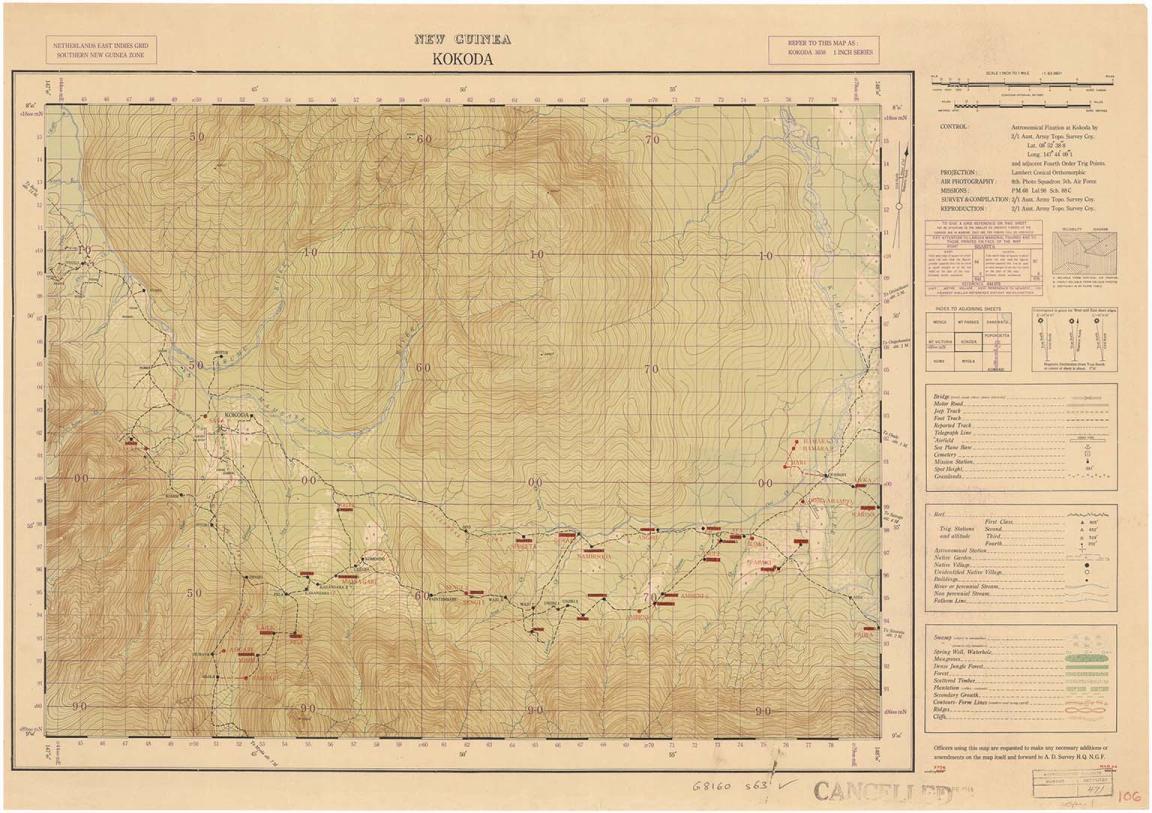
2/1st & Australia Army Topographical Survey Company, New Guinea Force, (1944), Kokoda, nla.gov.au/nla.obj-233565814
2/1st & Australia Army Topographical Survey Company, New Guinea Force, (1944), Kokoda, nla.gov.au/nla.obj-233565814
More resources
Discover items written in your language in the Library's collection with our catalogue advanced search. Click in the 'Language' field, and tick the box next to your language. If your language is not initially shown, click on 'more' and find it in the list. This type of language searching will list items across many formats as shown on the right menu, such as books, journals, music and pictures.
Some examples of resources in other languages include Marshallese, Tongan, Tok Pisin, Maori and Tuvaluan. There are many more but not all languages are represented in the collection. If you're not sure where to start, please Ask a Librarian.
Sometimes language results can overlap – this can be due to searching several language codes at once, or if multiple languages are covered by the same publication. This often occurs with dictionaries, religious titles or regional works. If your results include several languages, the menu on the right side will list these beneath the 'Language' option. Click the relevant language to further narrow the results.
Getting started with the catalogue illustrates these steps to guide you in finding items in your language.
Trove resources in your language
Trove is a discovery service which showcases records from many Australian libraries, museums and other cultural collecting institutions. To conduct a basic search from the Trove homepage, click into the white search bar and type the name of your language. Starting with this quick keyword search gives an insight into the materials and coverage. From the search results, choose a category such as Images, Maps & Artefacts. To refine, select 'Advanced search' on the right-hand menu and navigate to the 'Language' dropdown option and select 'Tok Pisin' or other options as applicable. Each category will list different languages, because these reflect the content of items within the respective formats.
The Trove search help page describes language search options and suggests searching for a keyword in that particular language. To continue a search for Tok Pisin material, create a basic search from the Trove homepage for the work 'pikinini' (child). This displays results across many categories. Another way to refine search results is to use the term 'language:' prior to the language name. For example, a basic search across all Trove categories for 'language:Tuvaluan' gives results which are very focused on linguistic materials.
Some search results are historical, such as the digitised issues of Harina, a Motu language journal published by the London Missionary Society. Other older publications include the full-text articles in Trove's Digitised Newspapers and Gazettes category. Several newspapers from Papua New Guinea can be viewed by their title listings, such as the Papua New Guinea Post-Courier (Port Moresby: 1969 – 1981). This newspaper coverage is provided within certain publication dates for copyright reasons, more modern news sources available through eResources are described above.
Recent news in the Pacific
The Library provides registered users with access to recent newspapers and magazines through subscription databases. Local and international titles relevant to the Pacific region are available through the eResources portal, with individual databases listed under the Browse eResources tab. More information on eResources is available on: Access eResources.
PressReader gives access to over 7,100 news and magazine publications in over 40 languages from more than 80 countries.
Articles are presented with full-colour images and dynamic page-turning with the same appearance as the printed publications. Search for countries of interest to see stories published internationally, or choose individual titles such as Bloomberg Businessweek (Asia), Fiji Sun, mailife, and PNG Now.
Current coverage from the past 3 months can be automatically translated with one click to 19 languages, including French and Japanese.
Newsbank Access Global is a major database with access to articles from over 7,000 news sources. Articles are text-based, with select titles providing full-colour images. Search for articles with keywords or by publication title such as Fiji Times, Marshall Islands Journal, or PACNEWS (Fiji). Refine by region with Map Search to see the BBC Monitoring Selected Reports for countries in the Pacific. Depending on the title, newspapers can be viewed or searched from the past few months or years.
These sites provide access to Pacific research in Australian universities and other scholarly communities.
- Australian Association for Pacific Studies
- Australia National University College of Asia and the Pacific
Their Pacific Institute serves as a hub connecting and promoting Pacific Studies research, teaching and training at ANU. - Australian Centre for Pacific Islands Research, University of the Sunshine Coast
- Centre for Asian and Pacific Law, The University of Sydney
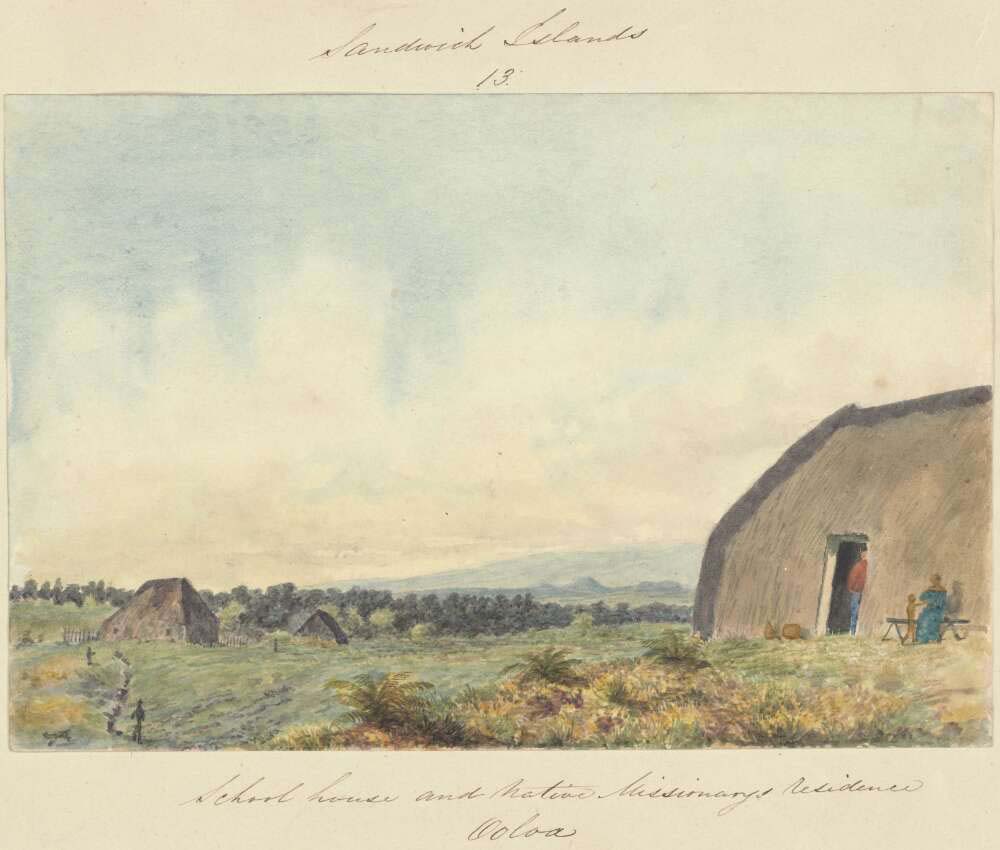
James Gay Sawkins, (1855), School house and native missionary's residence Ooloa [i.e. Olaa], Sandwich Islands, nla.gov.au/nla.obj-134664190
- Pacific Step-up: Department of Foreign Affairs and Trade
Australia's Pacific Step-up places people at the heart of our Pacific partnerships, with measures to strengthen and celebrate our people connections. - Pacific Economic Cooperation Council
PECC is a partnership of senior individuals from business and industry, government, academic and other intellectual circles. - Pacific Islands Forum Secretariat
Represents Heads of Government of all the independent and self-governing Pacific Island countries, Australia and New Zealand. Since 1971 it has provided member nations, currently numbering 16, with the opportunity to express their joint political views and to cooperate in areas of political and economic concern.
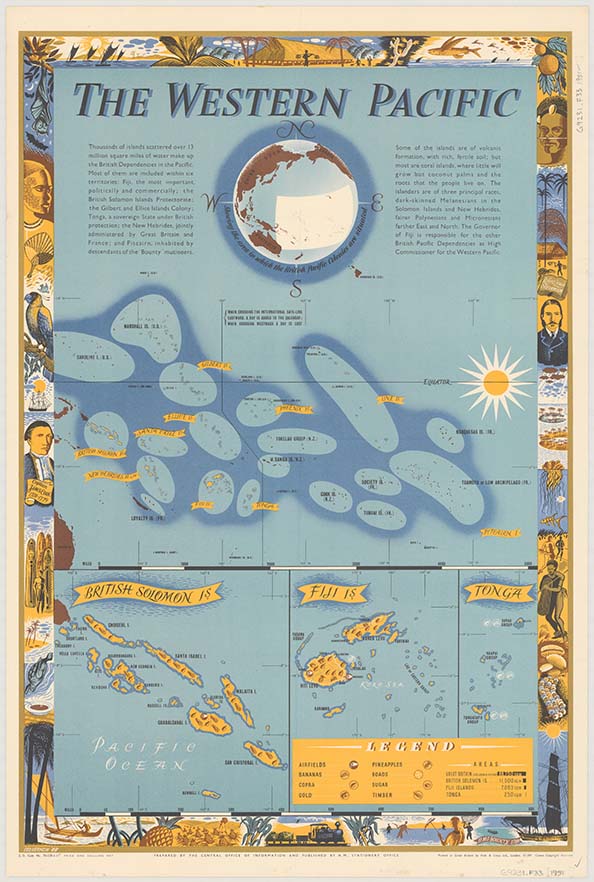
Great Britain. Central Office of Information. (1951). The Western Pacific, nla.gov.au/nla.obj-233249784
- National Library of New Zealand
Collects and maintains literature and information resources that relate to New Zealand and the Pacific. Links to the Alexander Turnbull library. - Pacific Manuscripts Bureau (PMB)
The Pacific Manuscripts Bureau copies archives, manuscripts and rare printed material relating to the Pacific Islands. Their website includes information on the materials sought and copied, catalogues and publications, current projects and recent releases of microfilms. - Pacific Research Archives (PRA)
The Pacific Research Archives at the Australian National University is the premier Australian centre for research and teaching resources on the Pacific. It ollects, preserves and provides access to unpublished and published research material from and about the Pacific Islands including records of companies and trade unions which operated in the Pacific and records of anthropologists, linguists geographers and historians who lived and worked in the Pacific. - University of Adelaide - Pacific Collection
The University's Pacific Collection of more than 8,000 volumes includes both books and journals on the history, culture, art, fiction and language of the Pacific islands of Melanesia, Micronesia and Polynesia, with particular emphasis on the central Pacific. Additional strengths include mission history and Pacific anthropology/ethnology journals. - University of the South Pacific
The premier provider of tertiary education in the Pacific region and an international centre of excellence for teaching, research consulting and training on all aspects of Pacific culture, environment and human resource development needs.
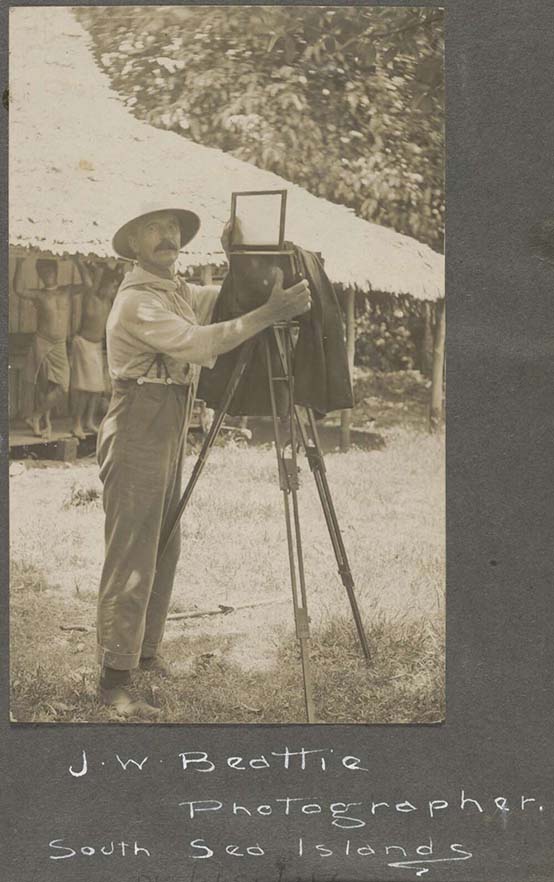
E. W. Searle, (1911), J.W. Beattie photographer, South Sea Islands, nla.gov.au/nla.obj-142169826
- Asia-Pacific Linguistics
- Te Puna Web Directory: News, Media and Publishing
Contains a selected list of Pacific sites - University of Hawaii Press
Provides a list of journal and new book titles published by the University - ANU Press - Pacific Series

Angus and Robertson booksellers, 89 Castlereagh Street, Sydney, 1915, nla.gov.au/nla.obj-138046678

